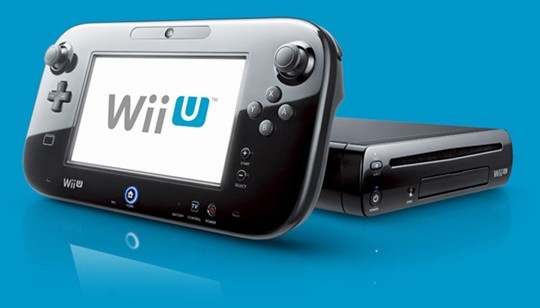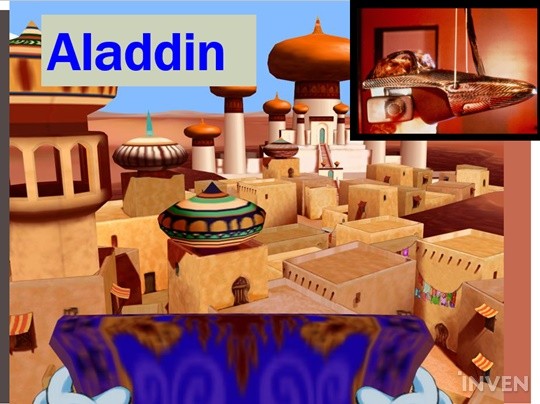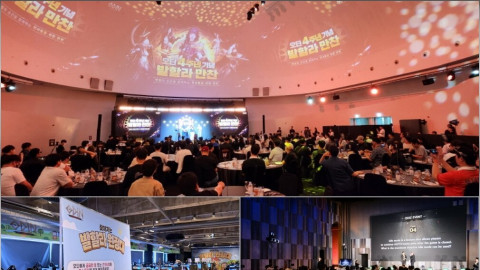
Innovative technology brings change. But change doesn't always bring success. Therefore, making accurate predictions before launching a new product - based on an organization's past failure - is extremely important.
Professor Don Marinelli of Columbia University shared his retrospective analysis regarding why or how some games and technologies have shaped our past, how they are affecting our present day, and how they will affect the future.
■Presentation Topic: The Failures and Success Stories of Entertainment Technology and what we can learn from them.
⊙ Learning from our past mistakes
An average person experiences far more failure than success within their lifetime. Of the two, it is failure that teaches the most potent and powerful lessons. The same can be said for the gaming industry. However, that which brought about success in the past is not absolutely certain to bring success today, and learning from our failures is not as easy as it sounds. The difficulties of finding success in gaming can be attributed to the constantly evolving nature of the market and the industry.
The gaming industry is still relatively young, and from within it, many successful games such as Tetris, Mario, and Pokemon have been developed and produced.
Back when 'Zynga' was a small company, Marinelli and his students were once invited to a party hosted by them. At the event, Zynga announced 'Farm Ville' to their visitors. Marinelli and his students were all awe-struck because, at the time, the idea of farming online was never heard of before. Since then, the company's worth, over time, skyrocketed to 100 million USD.

⊙ What success and failure looks like in Nintendo - The Wii
What exactly brings success? In order to better grasp the idea, it's necessary to look into some previously launched hardware.
Nintendo's original 'Wii' brought large success to Nintendo. No one expected the sales to be so successful, and that's why it came as a big surprise.
At the time, the Wii was comparable to pancakes. The system brought the whole family together to gather around the TV, just like how the ever-popular breakfast meal could be enjoyed by everyone in the family.
However, the Wii's success didn't come from its mass appeal alone. First of all, the Wii "sold". Seeing how money equates to success from a business stand point, its boom in initial sales was extremely important for VC backings; as investors tend to invest in what they see as most profitable.
The fact that the Wii had a reasonable price point also played a large part in its success. The Wii also massively contributed to the gaming industry by widening the general gaming demographic with its simple, easy-to-use design. Although there were other competitors on the market, the Wii introduced a brand new idea to gaming - it was the first system to successfully combine the fun of games with the simplicity of sports, and it attracted people of all ages to come and play.
There were and are many different platforms that end up failing due to the lack of content. But the Wii was not one of them. Being bundled with a diverse selection of content, it gave the Wii owners a constant supply of entertainment. Also, the long lasting corporate support that Nintendo gave to the Wii was definitely appealing to its users.

⊙What success and failure looks like in Nintendo - The Wii U
Sometime after the release of the Wii, Nintendo launched a follow-up console, the 'Wii U'. Although the system was basically a hardware upgrade from the original, it was seen as an inferior console when compared to its competitors at the time.
The Wii's controls were simple enough that even the elderly were able to easily enjoy it. The Wii U, on the other hand, had a much more complex setup. Also, in addition to its lack of third party support, its retail price was considered expensive, especially in light of its hardware and the amount of content it offered.
The Wii U lacked content, and it was unclear exactly who its target consumers was. The original Wii was enjoyed by people of all ages. The Wii U, however, was not made for the same mass appeal. The console was bundled with problems rather than actual content, and Nintendo failed to fix it before its launch. Their market tactics - including advertisement - failed miserably.

⊙What success and failure looks like in Nintendo - Fastest selling console, Nintendo Switch
Following their failure with the Wii U, Nintendo launched their new home console, the Switch. This system managed to strike a new record of being the fastest selling console, and it received endless attention from hardcore Nintendo fans and casual gamers alike. By selling approximately 2.74 million units in its first month of release, the sales prediction that claimed the "Switch will only sell around 20,000 units in its first month" was completely disproven.
The system was built around what made the original Wii successful, but with new additional technological features on top of it.
The system was also bundled with a great title on launch, 'The Legend of Zelda: Breath of the Wild'. It pulled off the "hybrid console" idea beautifully with a very reasonable price point.

⊙The 3D TV had everything it needed to be successful
The 3D TV was marked as a failure, but its existence helped guide the entertainment industry.
Everyone was excited when the first 3D Televisions launched. The enticing thought of watching their favorite shows from their couch - in a way that previously could only been seen in a 3D theatre - was enough to have people interested. But as all of you may already know, the said "breakthrough" technology ended up completely "disappearing" from the market.
The 3D TV's failure could be largely attributed to its lack of content.
When its number of sales started dwindling, 'DirecTV' stopped airing 3D channels in 2012. In the following year, ESPN also ceased to air their content in 3D.

The 3D TV was fully capable of running shows in 2D, and many people were thankful for that fact. But as you can see, the "3D" part of the "3D TV" wasn't really all that appealing to the majority. People found comfort in watching their shows in the more "conventional" 2D way and found no need to sacrifice the said comfort to watch their shows in 3D.
In order to use the 3D mode, you had to wear clunky and unflattering 3D glasses. People criticized the glasses, saying that it made people look fairly absurd when worn; this issue alone was enough to keep people from using the TV's 3D mode. It's also worth noting that the glasses applied stress to the eyes for the most viewers.
Sony's Aibo also taught us an important lesson. When the product was first announced, people were awestruck by the idea of having a robotic pet - but their dreams were soon crushed upon hearing the news that this robot dog cost two thousand dollars. Eventually, Sony had no choice but to "put down" the dog, ceasing its sales and corporate support.
The Galaxy Note 7 is another example. No one in their right mind expected their phones to blow up. The issue became such a problem for Samsung that it almost put the entire company in an irreversible crisis. But through the lesson learned from their failure, they made a comeback with the S8.
Coming equipped with the 'infinity display', the phone's interfaced was designed according to the feedback of Galaxy users. The hardware was much more stable compared to its predecessor, and it was also very sturdy. Its price was indeed expensive, but it was a phone that was well worth it.

⊙ The potential of AR
Currently, in the US, there have been many back-and-forth debates regarding the potential of 'Augmented Reality'.
Today, the VR market is much larger than its AR counterpart. But 'Digi-Capital' made a prediction that in 2020, the AR market will be around three times larger than the VR market; while also stating that video games will play a major role in the development of it.
You would be hard pressed to claim that AR is extremely profitable with the current state of the market. Nonetheless, the potential that AR possesses is definitely worth consideration. Even right now, if you go to an expo featuring IT technology, you will find AR glasses and other technology being displayed all over the place - though many of them are never sold; accessibility plays an important role in that regard. In fact, it may be the most important factor, as it the very reason that the original Wii was so appealing.
We can expect to see AR used in many ways in the future. Education, military, and even the medical field can all benefit massively from this technology. The fact that other industries already show a clear interest in AR shows how promising the potential of it really is.


When purchasing furniture from 'IKEA', you can "try" it before buying by placing it in a virtual home identical to yours. You can also get a document translated and ready to read by simply taking a picture of it. And very recently, IBM created an app that lets you take a picture of an aisle at your local store to see where all the products that you are looking for are located. The app also informs you of health benefits of a scanned product and provides you with links related to it. AR is already slowly seeping into our daily lives.
The line that separates success and failure is still too thin to comprehensively distinguish the two - at least at the moment. However, AR looks thoroughly promising, and any failure or success within the field will push the technology closer to its full potential. One example of this push can be found in the company 'Innovega'. Innovega introduced the idea of 'augmented contact lenses' - ones that could completely change your perspective of the world. The contacts are currently in development for military purposes, but we can definitely expect it to soon hit the market for regular consumers.
In order to find success with AR, we need to be well informed, while also informing others ourselves. With marketing, branding, and retail, we need to inform others of AR's immense potential.

⊙ Why did 'DisneyQuest' fail?
In 2017, 'Time Magazine' predicted that VR will change the world. Although we are still not that familiar with the technology, VR has actually been around for quite a long time.
In 1833, Charles Wheatstone "discovered" 3D tech. He invented the stereoscope, which is a device that uses two displays to add depth to a photo. Even today, the more recent VR HMD utilizes the same method.
As 3D technology saw development, it gave birth to DisneyQuest. Disney decorated its new theme park with diverse interactive 3D gaming equipment. But it closed about two years after its implementation.

Although there were a fair variety of issues with the attractions, the biggest one by far was that they were not able to keep up with the growth of the 3D technology. Constantly bringing in new and innovative technology came at a high financial cost, and outdated equipment brought just about the same amount of enjoyment that you could find in a local arcade. The theme park was also located in Chicago, which was and is infamous for having very cold winters. Visitors suing Disney for "accidents" caused by the dizziness brought about from their equipment also didn't help. So eventually, the theme park died out.
Of course, DisneyQuest isn't an example of the future of VR, as the technology still has a bright future ahead, alongside AR. Though the future of the technology may be bright, the road is nonetheless wrought with obstacles.
The first thing to consider is the effect that it has on our bodies (inducing nausea and physical accidents caused by the reduction of our peripheral vision). So in turn, we need to be well educated in order to use it as safely as possible.

⊙ In the end, it's simple
It is expected that the VR and AR market will have grown tremendously by 2020. Their growth in the market is on par with esports, which has also been growing at a breakneck pace. The gaming industry needs to prepare for the impending AR/VR era. And the preparations must be made according to the lessons that we've learned from our previous failures.
Is the tech truly profitable? Does it have the accessibility necessary to encourage people of all ages to enjoy it? Will its distribution network remain stable for a firm amount of time? Will it be acceptable for people of all ethnicities and cultures? There are many factors that make or break the sales and success of a product - but thankfully, we are starting to get a grasp on promising ideas based on our past experiences.
In the end, it's simple. "Don't look at something plainly. View it from all angles." That is how the gaming and entertainment industry will shape our future.

Sort by:
Comments :0







